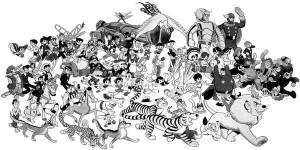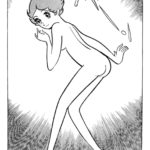Star System (Cast List)

Trying to find some information on your favourite Tezuka Star System player? Well, you’ve come to the right place.
Below you will find the complete Tezuka Star System Cast list – from Super Stars such as Astro Boy and Black Jack, to Minor Stars, such as Mittsun who you probably didn’t even know existed!
A Bit About Tezuka’s Stars
As most fans of Osamu Tezuka’s manga know, his Stars appear in many roles. Dr. Saruta, for example, has a recurring role in Phoenix (1967-88) and an equally important recurring role as “Dr. Honma” in Black Jack (1973-83). Sapphire is a huge star in her own Princess Knight [Nakayoshi] (1964-66) but only plays supporting roles in other works. While Hamegg, Acetylene Lamp or Kin Sankaku are cast in various supporting roles in the same work, Shunsaku Ban (a.k.a. “Higeoyaji”) appears to transcend his roles, appearing as basically the same character in almost every one of Tezuka’s manga works – beginning with his amateur efforts from his junior high school days.
Since many of Tezuka’s manga are science fiction—with “Astro Boy” being just one example—a lot of his characters play doctors/scientists or their assistants. In “Shōnen Manga Gahō” (Boys Manga Pictorial), Masahiko Kikuni wrote “When you talk about Tezuka’s manga, you’re talking about doctors/scientists”. “The Era of Osamu Tezuka” by Mitsutoshi Ishigami and “Osamu Tezuka Character Encyclopedia” by Hiroaki Ikeda each devote an entire chapter to the doctor/scientist characters, respectively entitled “one million doctors” and “one million scientists”. (The reason for the similar chapter titles in these books, which are not directly related, is that the chapter titles are taken from “Mahō Yashiki” (Magic Mansion)).
Unlike a real-life studio system, Tezuka’s Stars are all brought to life by his own imagination. As such, they are not confined by such things as age, race or gender in the same way real actors would be when being cast. While this is an amazing storytelling tool, it also makes the classification of their appearances difficult. Except in those rare cases were Tezuka himself left a record (either verbal or written) that “so-and-so” appeared in “such-and-such”, researchers are forced to resort to subjective judgement.
As a result, there are cases such as where Dr. Ochanomizu from “Astro Boy” is played by Sarutahiko from “Phoenix” according to “The Era of Osamu Tezuka” by Mitsutoshi Ishigami, whereas “Osamu Tezuka Character Encyclopedia” by Hiroaki Ikeda classifies Dr. Ochanomizu and Sarutahiko as separate characters.
Of course, with so many of his Stars appearing over and over again, with different names in different works, it is important to establish a “stage name” for each one to avoid confusion or duplication. Again, this is sometimes rather a subjective effort by researchers. While they often simply take the name from the first appearance, this is not always the case. In some cases (Ossan or Dekobin for example), the stage name is not the character’s name in any of the manga, but Tezuka himself left a record of the “official” stage name and so this is, of course, given the top priority. In others, such as in the case of Buku Bukku or Mitchy, the stage name is not the character’s name in the debut appearance—it is from the manga they made their second appearance in (or even later)—but Tezuka indicated the stage name and so it is given priority.
Of course, there is the added complexity of documenting the Stars in English and not the original Japanese. In most cases the Japanese name has been retained and a “Hello, my name (in English)” section has been used to explain the inherent Japanese pun (where necessary) rather than attempting to translate them directly or finding an English language equivalent. However, in those cases (such as “The King from Faust“) where a translation is appropriate, it has been made. Of course, in the (very) few cases, such as Atom (a.k.a. “Astro Boy“) or Leo (a.k.a. “Kimba the White Lion”), where the English version of the name is nearly as well known as the original, it is included as well.
Status: God of Manga (★★★★★★)
Well, there is only one.
 Say hello to Maria! -
Say hello to Maria! - When Yakeno Yahachi, better known to his friends as “Yakeppachi” (i.e. “desperate”), has ectoplasm seep out of his nose, he does what any normal teenage boy would do - he puts it in a life-like doll suit, names her Maria, and has her attend high school alongside him.
Status: Super Stars (★★★★★)
You know them and you love them! Tezuka’s Super Stars are in a class by themselves. His most high-profile characters, they are easily recognizable as the stars of his major works.
Status: Major Stars (★★★★)
Tezuka’s Major Stars are either the titular characters of his more popular works, or the most well-known and often cast members of this supporting heroes and villains who appear in the vast majority of his manga works.
Status: Primary Stars (★★★)
Although perhaps less recognizable than his major stars, Tezuka’s Series Leads have what it takes to carry a story. These are either the main pro/antagonists and/or their strongest supporting characters.
Status: Secondary Stars (★★)
The role players. Tezuka’s Secondary Stars have appeared in many series, usually in supporting roles.
Status: Minor Stars (★)
The bit players. Need a single line delivered? Need some faces in the crowd? Tezuka’s Minor Stars are his go-to cast to fill a minor role with a steady and experienced hand.
Status: Manga Artists, Animators and Novelists
Every once in a while, some familiar faces pop-up in Tezuka’s works. Tezuka was not above casting his real-life friends and contemporaries in minor roles – including himself!
Status: Other Organisms
Tezuka’s manga works are frequently beset by a host of strange organisms that pop-up when you least expect it.


